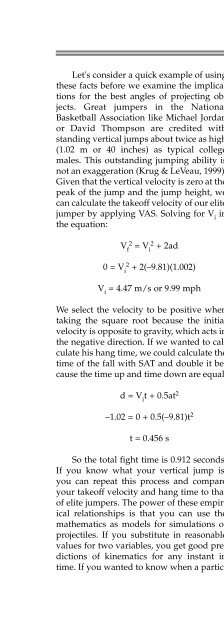Fundamentals of Biomechanics
Fundamentals of Biomechanics
Fundamentals of Biomechanics
You also want an ePaper? Increase the reach of your titles
YUMPU automatically turns print PDFs into web optimized ePapers that Google loves.
Let's consider a quick example <strong>of</strong> using<br />
these facts before we examine the implications<br />
for the best angles <strong>of</strong> projecting objects.<br />
Great jumpers in the National<br />
Basketball Association like Michael Jordan<br />
or David Thompson are credited with<br />
standing vertical jumps about twice as high<br />
(1.02 m or 40 inches) as typical college<br />
males. This outstanding jumping ability is<br />
not an exaggeration (Krug & LeVeau, 1999).<br />
Given that the vertical velocity is zero at the<br />
peak <strong>of</strong> the jump and the jump height, we<br />
can calculate the take<strong>of</strong>f velocity <strong>of</strong> our elite<br />
jumper by applying VAS. Solving for V i in<br />
the equation:<br />
V f 2 = Vi 2 + 2ad<br />
0 = V i 2 + 2(–9.81)(1.002)<br />
V i = 4.47 m/s or 9.99 mph<br />
We select the velocity to be positive when<br />
taking the square root because the initial<br />
velocity is opposite to gravity, which acts in<br />
the negative direction. If we wanted to calculate<br />
his hang time, we could calculate the<br />
time <strong>of</strong> the fall with SAT and double it because<br />
the time up and time down are equal:<br />
d = V i t + 0.5at 2<br />
–1.02 = 0 + 0.5(–9.81)t 2<br />
t = 0.456 s<br />
So the total fight time is 0.912 seconds.<br />
If you know what your vertical jump is,<br />
you can repeat this process and compare<br />
your take<strong>of</strong>f velocity and hang time to that<br />
<strong>of</strong> elite jumpers. The power <strong>of</strong> these empirical<br />
relationships is that you can use the<br />
mathematics as models for simulations <strong>of</strong><br />
projectiles. If you substitute in reasonable<br />
values for two variables, you get good predictions<br />
<strong>of</strong> kinematics for any instant in<br />
time. If you wanted to know when a partic-<br />
CHAPTER 5: LINEAR AND ANGULAR KINEMATICS 117<br />
ular height was reached, what two equations<br />
could you use? Could you calculate<br />
how much higher you could jump if you increased<br />
your take<strong>of</strong>f velocity by 10%?<br />
So we can see that uniformly accelerated<br />
motion equations can be quite useful in<br />
modeling the vertical kinematics <strong>of</strong> projectiles.<br />
The final important point about uniformly<br />
accelerated motion, which reinforces<br />
the directional nature <strong>of</strong> vectors, is<br />
that, once the object is released, the vertical<br />
component <strong>of</strong> a projectile's velocity is independent<br />
<strong>of</strong> its horizontal velocity. The extreme<br />
example given in many physics<br />
books is that a bullet dropped the same instant<br />
another is fired horizontally would<br />
strike level ground at the same time. Given<br />
constant gravitational conditions, the<br />
height <strong>of</strong> release and initial vertical velocity<br />
uniquely determine the time <strong>of</strong> flight <strong>of</strong><br />
the projectile. The range or horizontal distance<br />
the object will travel depends on this<br />
time <strong>of</strong> flight and the horizontal velocity.<br />
Athletes may increase the distance they can<br />
throw by increasing the height <strong>of</strong> release<br />
(buying time against gravity), increasing<br />
vertical velocity, and horizontal velocity.<br />
The optimal combination <strong>of</strong> these depends<br />
on the biomechanics <strong>of</strong> the movement, not<br />
just the kinematics or trajectory <strong>of</strong> uniformly<br />
accelerated motion. The next section will<br />
summarize a few general rules that come<br />
from the integration <strong>of</strong> biomechanical models<br />
and kinematic studies <strong>of</strong> projectile activities.<br />
These rules are the basis for the Optimal<br />
Projection Principle <strong>of</strong> biomechanics.<br />
OPTIMAL PROJECTION<br />
PRINCIPLE<br />
For most sports and human movements involving<br />
projectiles, there is a range <strong>of</strong> angles<br />
that results in best performance. The<br />
Optimal Projection Principle refers to the<br />
angle(s) that an object is projected to<br />
achieve a particular goal. This section will






